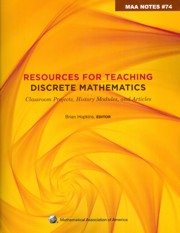Book contents
- Frontmatter
- Introduction
- Dedication
- Contents
- I Classroom-tested Projects
- II Historical Projects in Discrete Mathematics and Computer Science
- Introduction
- Binary Arithmetic: From Leibniz to von Neumann
- Arithmetic Backwards from Shannon to the Chinese Abacus
- Pascal's Treatise on the Arithmetical Triangle: Mathematical Induction, Combinations, the Binomial Theorem and Fermat's Theorem
- Early Writings on Graph Theory: Euler Circuits and The Königsberg Bridge Problem
- Counting Triangulations of a Convex Polygon
- Early Writings on Graph Theory: Hamiltonian Circuits and The Icosian Game
- Are All Infinities Created Equal?
- Early Writings on Graph Theory: Topological Connections
- A Study of Logic and Programming via Turing Machines
- Church's Thesis
- Two-Way Deterministic Finite Automata
- III Articles Extending Discrete Mathematics Content
- IV Articles on Discrete Mathematics Pedagogy
- About the Editor
Early Writings on Graph Theory: Hamiltonian Circuits and The Icosian Game
from II - Historical Projects in Discrete Mathematics and Computer Science
- Frontmatter
- Introduction
- Dedication
- Contents
- I Classroom-tested Projects
- II Historical Projects in Discrete Mathematics and Computer Science
- Introduction
- Binary Arithmetic: From Leibniz to von Neumann
- Arithmetic Backwards from Shannon to the Chinese Abacus
- Pascal's Treatise on the Arithmetical Triangle: Mathematical Induction, Combinations, the Binomial Theorem and Fermat's Theorem
- Early Writings on Graph Theory: Euler Circuits and The Königsberg Bridge Problem
- Counting Triangulations of a Convex Polygon
- Early Writings on Graph Theory: Hamiltonian Circuits and The Icosian Game
- Are All Infinities Created Equal?
- Early Writings on Graph Theory: Topological Connections
- A Study of Logic and Programming via Turing Machines
- Church's Thesis
- Two-Way Deterministic Finite Automata
- III Articles Extending Discrete Mathematics Content
- IV Articles on Discrete Mathematics Pedagogy
- About the Editor
Summary
Introduction
Problems that are today considered to be part of modern graph theory originally appeared in a variety of different connections and contexts. Some of these original questions appear little more than games or puzzles. In the instance of the ‘Icosian Game’, this observation seems quite literally true. Yet for the game's inventor, the Icosian Game encapsulated deep mathematical ideas which we will explore in this project.
Sir William Rowan Hamilton (1805–1865) was a child prodigy with a gift for both languages and mathematics. His academic talents were fostered by his uncle James Hamilton, an Anglican clergyman with whom he lived from the age of 3. Under his uncle's tutelage, Hamilton mastered a large number of languages – including Latin, Greek, Hebrew, Persian, Arabic and Sanskrit – by the age of 10. His early interest in languages was soon eclipsed by his interests in mathematics and physics, spurred in part by his contact with an American calculating prodigy. Hamilton entered Trinity College in Dublin in 1823, and quickly distinguished himself. He was appointed Astronomer Royal of Ireland at the age of 22 based on his early work in optics and dynamics. Highly regarded not only by his nineteenth century colleagues, Hamilton is today recognized as a leading mathematician and physicist of the nineteenth century.
In mathematics, Hamilton is best remembered for his creation of a new algebraic system known as the ‘quaternions’ in 1843.
- Type
- Chapter
- Information
- Resources for Teaching Discrete MathematicsClassroom Projects, History Modules, and Articles, pp. 217 - 224Publisher: Mathematical Association of AmericaPrint publication year: 2009
- 1
- Cited by

